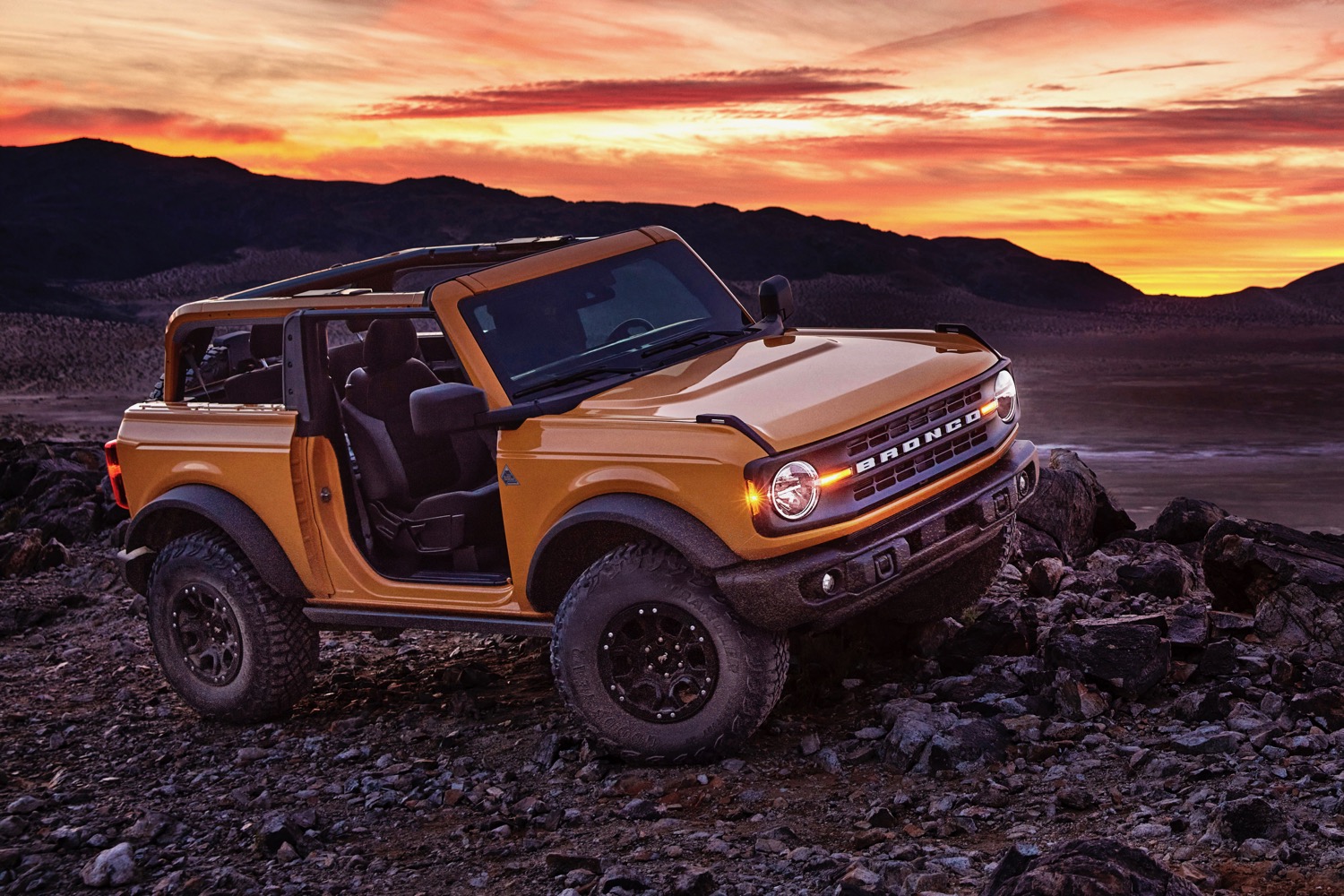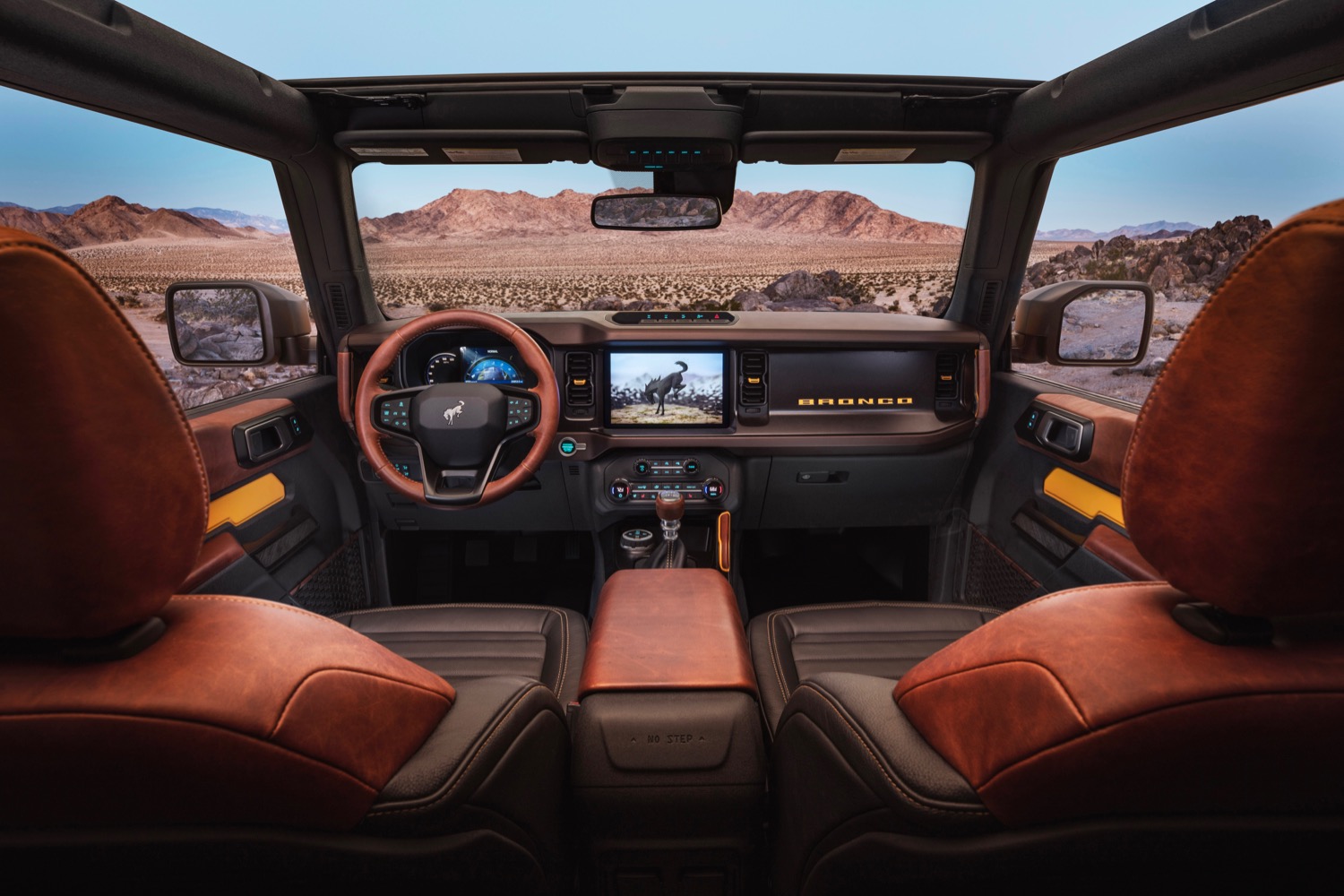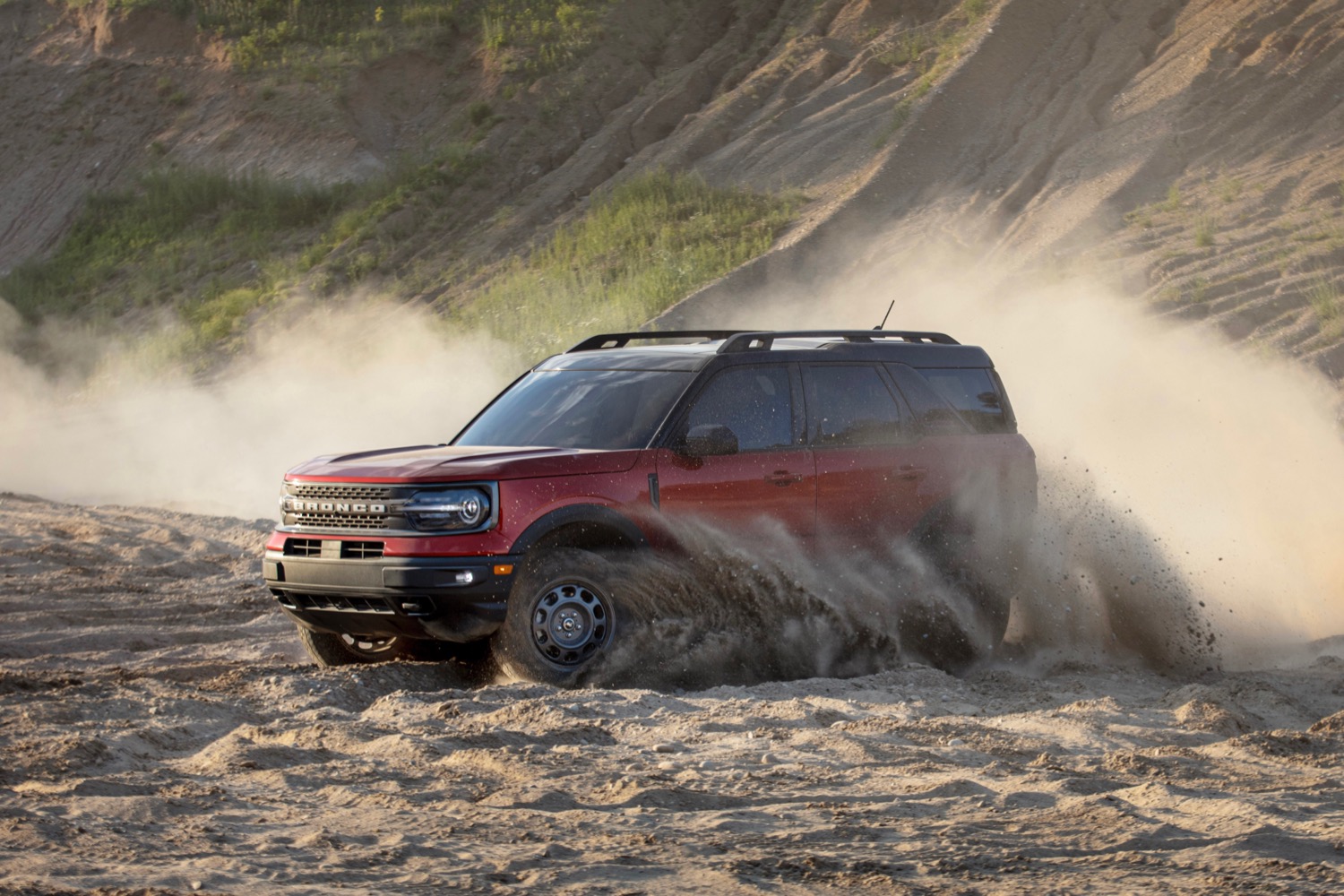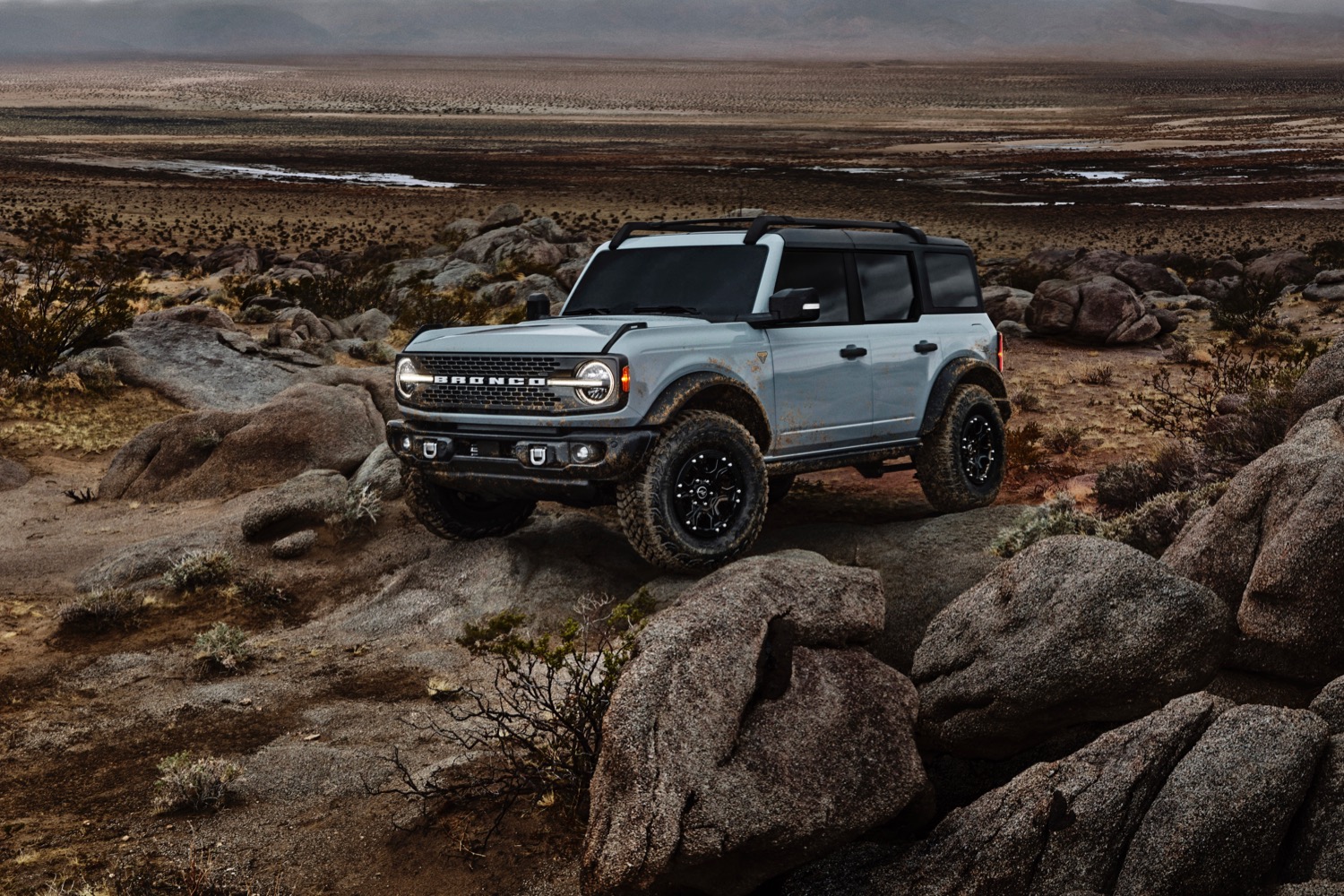The Ford Bronco was one of the original SUVs, but Ford discontinued it in 1996. Since then, SUVs have massively grown in popularity, so it was only a matter of time before Ford brought the Bronco back.
Current SUV popularity also means Ford could have phoned this one in and still sold herds of new Broncos, but that isn’t what the Blue Oval did. The 2021 Ford Bronco has the off-road capability fans expect, but it also boasts tech geared specifically toward outdoor adventure. It’s much more than a big dumb truck with a big screen slapped on.
Design
The new Bronco isn’t one vehicle; it’s three. Like the rival Jeep Wrangler, the 2021 Bronco will be available in two-door and four-door configurations, both with removable doors and roof. In addition, the 2021 Ford Bronco Sport is a smaller vehicle based on a different platform, but sharing exterior styling and some of the off-road tech of the larger Bronco. It’s pitched against the Jeep Compass and Renegade.
The exterior styling of all three models is heavily influenced by the first-generation Bronco, which debuted in 1965. All three models get the classic Bronco “face,” with a flat rectangular grille flanked by round headlights. Designers actually scanned a classic Bronco owned by Ford design vice president Moray Callum to get the look just right, Bronco chief designer Paul Wraith told Digital Trends.

The Bronco two-door and four-door models both get three-piece removable roofs, and four-door models get a standard cloth convertible top that can be used when the hard roof panels are off. The removable doors are frameless, making them and lighter and thus easier to get on and off. Unlike the Jeep Wrangler, Ford claims the doors can be stored onboard (on four-door models, at least).
The Bronco Sport doesn’t get a removable roof or doors, but Ford worked to maximize interior space within its relatively small footprint. The automaker claims two 27.5-inch mountain bikes can be stored in the cargo area (with an optional Yakima rack), and the sports floodlights and a taller-than-normal opening height, so it can serve as a shady trailside hangout spot. Both the standard Bronco and the Bronco Sport also have rubberized floors to make cleaning mud and dirt easier, plus a built-in bottle opener in the cargo area.
Tech
Even if a vehicle is capable of tackling the toughest off-road trails, its driver may not be. So Ford gave the Bronco and Bronco Sport tech features designed to make off-roading easier and more accessible to people of all skill levels.
Both the Bronco and Bronco Sport get Ford’s Terrain Management System, which adjusts various vehicle parameters for different types of terrain. In the Bronco models, the terrain-specific driving modes are called “G.O.A.T. modes,” short for “goes over any terrain,” and a reference to Ford executive Donald Frey’s nickname for the original Bronco.
Up to seven modes are available, depending on the vehicle and trim level, including: Normal, Eco, Sport, Slippery and Sand, Baja, Mud/Ruts, and Rock Crawl. The electronic aids were tuned to work with drivers, rather than try to outsmart them, Adrian Aguirre, Bronco Sport chief engineer, told Digital Trends.

The Bronco and Bronco Sport also get Trail Control. Previously seen in the Ford Ranger pickup truck, it basically acts as low-speed, off-road cruise control, handling the throttle and brakes while the driver steers. The Bronco also gets an optional 360-degree camera system with “spotter view,” which shows the view directly in front of each tire. Not available on the Bronco Sport, the feature is designed to lessen the need for a spotter outside the vehicle while off-roading, Donna Bell, Ford director, tech and features strategy and planning, told Digital Trends.
The Bronco is one of the first Ford models to get the automaker’s new Sync 4 infotainment system. It includes standard wireless Apple CarPlay and Android Auto, over-the-air updates, and more than 1,000 trail maps built into its navigation system. An 8.0-inch touchscreen is standard, but a 12.0-inch screen is also available. Sync 4 also has twice the computing power of the previous Sync 3 system, Bell told Digital Trends. Device attachment points and 12-volt connectors are also built into the dashboard for hooking up cameras or phones.
The Bronco Sport gets the old Sync 3 infotainment system, with an 8.0-inch touchscreen and standard Apple CarPlay and Android Auto (you’ll still need a cable for both). However, the Sport gets driver aids not available in the standard Bronco, including adaptive cruise control, lane centering, and traffic sign recognition.
Specifications
The Bronco two-door and four-door are body-on-frame vehicles, based on a modified version of the Ford Ranger platform. Ford quoted ground clearance of 11.6 inches, 29-degree breakover angle, 37.2-degree departure angle. Those figures all beat the Jeep Wrangler, the Bronco’s main rival. If you’re feeling adventurous, the Bronco can also wade through up to 33.5 inches of water, according to Ford.
The base engine is a 2.3-liter turbocharged four-cylinder unit shared with the Ranger and other Ford products. In the Bronco, it makes 270 horsepower and 310 pound-feet of torque. Ford also offers an optional 2.7-liter turbocharged V6, with 310 hp and 400 lb-ft. Both engines are available with a seven-speed manual or 10-speed automatic transmission. The V6 offers less horsepower than the equivalent Wrangler engine, but with more torque. However, Jeep offers an EcoDiesel Wrangler with 442 lb-ft, and is rolling out hybrid options.
Four-wheel drive is standard, but Ford gives buyers a choice of two systems. The base system is fully electronic, while the optional system is a beefier electromechanical setup. Power is distributed through Dana axles, from the same supplier used by Jeep. An optional Sasquatch Package aimed at hardcore off-road enthusiasts adds 35-inch tires on 17-inch Beadlock-ready rims.

On pavement, the Bronco will never be confused with a sports car. However, Ford did include some features to improve road manners. The Bronco gets independent front suspension with an electronically disconnecting front sway bar. The body stays in place to limit body roll in corners, but disconnects when off-roading to increase axle articulation.
Engineering wise, the Bronco Sport is completely different from the standard Bronco. Instead of truck-like body-on-frame construction, it has a car-like unibody derived from the Ford Escape. The Escape isn’t known for off-road capability, so Ford gave the Bronco Sport a model-specific four-wheel-drive system and optional 29-inch tires.
Powertrains are shared with the Escape, however. The base Bronco Sport engine is a 1.5-liter turbocharged three-cylinder making 181 hp and 190 lb-ft. The buyer can upgrade to a 2.0-liter turbocharged four-cylinder, rated at 245 hp and 275 lb-ft. Both engines come with an eight-speed automatic transmission, with standard four-wheel drive.
Pricing
The 2021 Ford Bronco starts at $29,995 for a base two-door model, and is expected to hit dealerships in Spring 2021. The Bronco Sport starts at $26,660, and is scheduled to arrive before the end of 2020. Both vehicles can be reserved online with a $100 refundable deposit.
Updated on July 14, 2020: Added pricing for the Bronco Sport.



